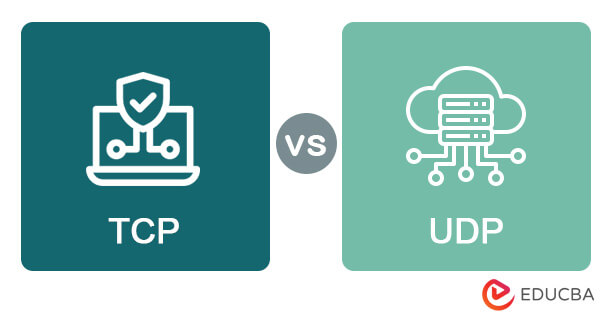Updated May 4, 2023
Difference Between TCP vs UDP
The following article provides an outline for TCP vs UDP. TCP is link-oriented, and UDP is connection-free. TCP links the transmitter to the receiver until data can be transmitted. Until transmitting data, UDP does not create a connection. TCP is trustworthy. The receiver expects to receive data transmitted via a TCP protocol. It retrieves data and sends back lost data. TCP monitors and tracks error packages to prevent data loss or corruption.
What is TCP?
TCP stands for Transmission Control Protocol. TCP is a connection-oriented protocol, i.e., it provides a process to process (end-to-end) communications. The transmission control protocol shows the relationship between other protocols in the TCP/IP protocol. It is an intermediary between the application program and network operations as it lies between the application and network layers. TCP delivers data or messages in the form of packets. TCP provides different features like sequence number, flow control, error control, acknowledgment number, congestion control, etc., to ensure that other activities cannot affect the delivered packet.
What is UDP?
UDP stands for User Datagram Protocol. It is used to send a small message from one host to another. It is a connectionless protocol, i.e., transferring data from one end to another; there is no need for connection establishment. UDP also lies between the application layer and the network layer. It also delivers data or information in the form of packets; these packets are called user datagrams. UDP uses multiplexing to handle the outgoing user datagrams from multiple processes and demultiplexing to handle the incoming user datagrams that go to different processes on the same host.
Comparison Between (Infographic)
Below is the list of the top 11 differences between TCP and UDP:
Key Difference Between TCP vs UDP
Let us discuss some of the major key differences between TCP and UDP:
- One of the main key differences between TCP and UDP is TCP is connection-oriented, and UDP is connectionless. To transfer data, TCP must establish a connection with other hosts.
- TCP uses sequence numbers for numbering the packets during the transmission of data. So that at the receiver site, data can be collected sequentially using sequence numbers. While UDP does not use sequence numbers to number the packets, it isn’t easy.
- TCP provides a flow control service to handle the receiving data’s overflow, while UDP does not provide a flow control service.
- TCP provides reliable services, while UDP does not offer reliable services.
- In TCP, retransmission of the segment occurs through the window mechanism. Since there is no window mechanism in UDP, it does not support the retransmission of the datagram.
- TCP assigns an acknowledgment number to each segment, whereas UDP does not use an acknowledgment number for datagrams.
- TCP is a linked protocol, while UDP is connection-free. This means TCP tracks all transmitted data and usually requires acknowledgment per byte. UDP is generally used on protocols where a few lost datagrams don’t matter. It doesn’t use any accreditation. TCP is a secure information transfer protocol because of its acknowledgments. It guarantees that the system sends only ordered, non-duplicated, and complete information to the top-layer application.
- TCP provides services such as Process to process communication, stream delivery service, flow control, error control, congestion control, full-duplex communication, multiplexing, demultiplexing, acknowledgment number, system number, sequence number, and byte number. In contrast, UDP has features like Process to process communication, multiplexing, and demultiplexing, along with Encapsulation and decapsulation.
- TCP has features such as flow control using sliding windows, window side adjustment heuristics, and congestion avoidance algorithms to manage data flow. At the same time, UDP does not provide features to collect the data flow.
- Data Quality Sustainability is outstanding in TCP compared to UDP because it can manage small to extensive data, while UDP can handle small to moderate amounts of data.
Comparison Table of TCP vs UDP
The table below summarizes the comparisons between TCP vs UDP:
|
Points |
TCP |
UDP |
| Full Form | TCP stands for Transmission Control Protocol. | UDP stands for User Datagram Protocol. |
| Protocol | TCP is connection-oriented. | UDP is connectionless. |
| Packet Format | Packets in TCP are called a segment. | Packets in UDP are called user datagrams. |
| Header Size | TCP header is 8 bytes. | UDP header is 20 to 60 bytes. |
| Acknowledgment | TCP is a connection-oriented service that sends an acknowledgment when all the data is delivered. | UDP does not send an acknowledgment when data delivery is done because it is a connectionless service. |
| Error Control Mechanism | TCP supports an error control mechanism. | There is no error control mechanism in UDP except for checksum. |
| The Process to Process Communication | It provides a process to process communication using port numbers. | It provides the Process to process communication using port numbers and IP addresses. |
| Transmission Speed | The transmission speed of the packet is low. | The transmission speed of the packet is high. |
| Services | The Process to process communication, stream delivery service, reliable service, flow control, error control, congestion control, full-duplex communication, multiplexing, demultiplexing, acknowledgment number, system number, sequence number, and byte number. | The Process to process communication, Encapsulation, decapsulation, multiplexing, and demultiplexing. |
| Reliability | More reliable. | Moderately reliable as compared to TCP. |
| Window Mechanism | In TCP, the window mechanism Is there. | In UDP, there is no window mechanism. |
Conclusion
This article shows what TCP and UDP, head-to-head comparisons, and their key differences are.
Recommended Articles
This has been a guide to TCP vs UDP. Here we discuss the overview of TCP vs UDP and see the head-to-head comparison and key differences. You can also go through our other suggested articles to learn more –


